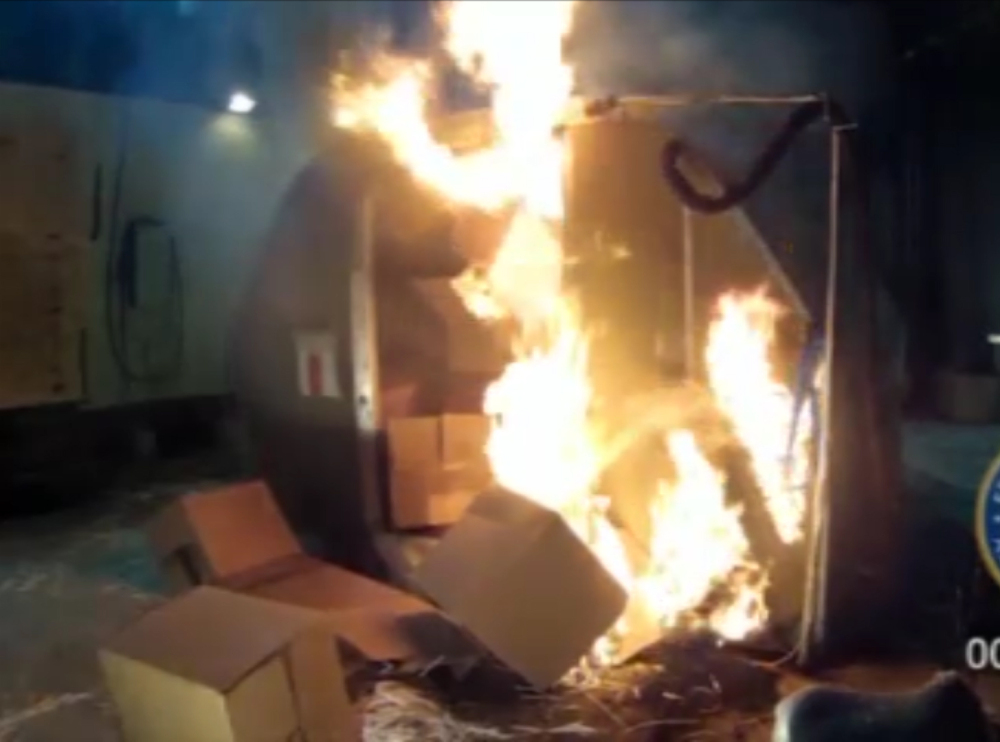WASHINGTON — Dramatic U.S. government test results raise new concern that bulk shipments of rechargeable lithium batteries carried as cargo on passenger planes are susceptible to fires or explosions that could destroy the airliners.
Yet U.S. and international officials have been slow to adopt safety restrictions that might affect the powerful industries that depend on the batteries and the airlines that profit from shipping them. The batteries are used in products ranging from cellphones and laptops to hybrid cars.
Shipments of rechargeable batteries on passenger planes are supposed to be limited to no more than a handful in a single box, under safety standards set by the U.N.’s International Civil Aviation Organization and adopted by the U.S. and other nations. But a loophole permits shippers to pack many small boxes into one shipment and get around the rules. Tens of thousands of the batteries may be packed into pallets or containers and loaded into the cargo holds of wide-body passenger planes.
In an April test by the Federal Aviation Administration, a cargo container was packed with 5,000 lithium-ion batteries and a cartridge heater added to simulate a single battery experiencing uncontrolled overheating. The heat from the cartridge triggered escalating overheating in nearby batteries, which spread in a chain reaction. Temperatures reached about 1,100 degrees Fahrenheit.
Once about 300 batteries had become involved, a fierce explosion blew open the container door and sent boxes flying, catching FAA and industry observers by surprise. Within seconds, the cargo container was in flames. The explosion came from a buildup of flammable gases.
A second test in September produced similar results, despite the addition of a fire suppression agent. Safety authorities have long known that lithium-ion batteries can fuel violent fires if they are defective, damaged, overcharged, incorrectly packaged or exposed to extreme heat. But they have been allowed to be shipped on passenger planes because it was thought the halon gas fire suppression systems in the cargo compartments of airliners could extinguish any fire.
The container tests have raised a new worry: that an explosion could increase pressure in the cargo hold, activating depressurization valves that would let halon gas and smoke vent into the passenger cabin and cockpit. That would dilute fire suppression in the hold and let a fire rage unchecked.
The cargo problem is distinct from the one that caused a fire two years ago in a lithium-ion battery installed as part of the operating system of a Boeing 787. In that case, Boeing failed to anticipate that a short circuit in one of the battery’s eight cells could spread to the other cells and ignite a fire, the National Transportation Safety Board said Monday.
The U.N.’s civil aviation agency is considering a series of proposals to strengthen packaging, labeling and handling standards for lithium-ion battery shipments, and airline pilot unions are pushing for limits on the number of batteries that can be transported. No consensus emerged at an October meeting in Brazil, and any changes aren’t expected to take effect until 2017.
By contrast, the U.N. agency decided earlier this year to ban shipments on passenger planes of lithium metal batteries, a non-rechargeable cousin to lithium-ion batteries typically used in toys, watches and medical devices. That ban goes into effect in January.
Copy the Story LinkSend questions/comments to the editors.



Success. Please wait for the page to reload. If the page does not reload within 5 seconds, please refresh the page.
Enter your email and password to access comments.
Hi, to comment on stories you must . This profile is in addition to your subscription and website login.
Already have a commenting profile? .
Invalid username/password.
Please check your email to confirm and complete your registration.
Only subscribers are eligible to post comments. Please subscribe or login first for digital access. Here’s why.
Use the form below to reset your password. When you've submitted your account email, we will send an email with a reset code.